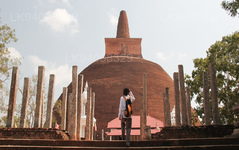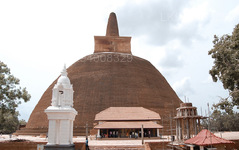
Ciudad de Anuradhapura
Anuradhapura pertenece a la Provincia Central del Norte de Sri Lanka. Anuradhapura es una de las antiguas capitales de Sri Lanka, famosa por sus ruinas bien conservadas de la antigua civilización de Sri Lanka. La ciudad, declarada Patrimonio de la Humanidad por la UNESCO, se encuentra a 205 km al norte de la actual capital, Colombo, en Sri Lanka.
Abhayagiri Dagoba
Abhayagiri Vihāra was a major monastery site of Mahayana, Theravada and Vajrayana Buddhism that was situated in Anuradhapura, Sri Lanka. It is one of the most extensive ruins in the world and one of the most sacred Buddhist pilgrimage cities in the nation. Historically it was a great monastic centre as well as a royal capital, with magnificent monasteries rising to many stories, roofed with gilt bronze or tiles of burnt clay glazed in brilliant colors. To the north of the city, encircled by great walls and containing elaborate bathing ponds, carved balustrades and moonstones, stood "Abhayagiri", one of seventeen such religious units in Anuradhapura and the largest of its five major viharas. One of the focal points of the complex is an ancient stupa, the Abhayagiri Dagaba. Surrounding the humped dagaba, Abhayagiri Vihara was a seat of the Northern Monastery, or Uttara Vihara and the original custodian of the Tooth relic in the island.
The term "Abhayagiri Vihara" refers not only to the complex of monastic buildings, but also a fraternity of Buddhist monks, or Sangha, which maintained its own historical records, traditions and way of life. Founded in the 2nd century BC, it had grown into an international institution by the 1st century AD, attracting scholars from all over the world and encompassing all shades of Buddhist philosophy. Its influence can be traced to other parts of the world, through branches established elsewhere. Thus, the Abhayagiri Vihara developed as a great institution vis‑a‑vis the Mahavihara and the Jetavana Buddhist monastic sects in the ancient Sri Lankan capital of Anuradhapura.
It is recorded in the chronicle that Abhayagiri Dagaba was established by King Valagamba during the period of his second reign, from 89-77 B.C.E. A young Brahmin named Tiya (Tissa) declared war against him. Tiya was deluded by the prophecy of another Brahmin that was destined to be king. Before the arrival of Bhikkhu Mahinda, who brought Buddhism to the island, Brahmins held the highest place in society. After the establishment of the Buddhist sangha on the island, however, they lost their supremacy, and were replaced by the sangha. Some Brahmins converted to Buddhism, while others revolted. Tiya, who enjoyed the support of his community, lived both in and outside of Sri Lanka, and was therefore very powerful.
Acerca del distrito de Anuradhapura
Anuradhapura pertenece a la Provincia Central del Norte de Sri Lanka. Anuradhapura es una de las antiguas capitales de Sri Lanka, famosa por sus ruinas bien conservadas de la antigua civilización de Sri Lanka. La ciudad, declarada Patrimonio de la Humanidad por la UNESCO, se encuentra a 205 km al norte de la actual capital, Colombo, en Sri Lanka. En la ciudad sagrada de Anuradhapura y sus alrededores se encuentran numerosas ruinas. Estas consisten en tres tipos de edificios: dagobas, edificios monásticos y pokuna (estanques). La ciudad contaba con algunos de los sistemas de riego más complejos del mundo antiguo. Ubicada en la zona árida del país, la administración construyó numerosos tanques para regar la tierra. La mayoría de la población civil es cingalesa, mientras que en el distrito viven tamiles y moros de Sri Lanka.
Acerca de la Provincia Central del Norte
La Provincia Central del Norte, que es la provincia más grande del país, cubre el 16% de la superficie total del país. La Provincia Central del Norte consta de dos distritos llamados Polonnaruwa y Anuradhapure. Anuradhapura es el distrito más grande de Sri Lanka. Su área es de 7.128 km². La Provincia Central del Norte tiene numerosos potenciales para que los inversores inicien sus negocios, especialmente la agricultura, las industrias basadas en la agricultura y los sectores ganaderos. Más del 65% de la gente de la Provincia Central del Norte depende de la agricultura básica y las industrias basadas en la agricultura. NCP también se llama "Wew Bendi Rajje" porque hay más de 3.000 tanques de escala mediana y grande situados en la provincia. Sri maha bodiya, Ruwanweli seya, Thuparama dageba, Abayagiri Monastry, Polonnaruwa Rankot wehera, Lankathilake están asustados














